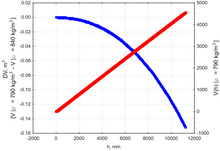Custody Transfer in the oil and gas industry refers to the transactions involving transporting physical substance from one operator to another. This includes the transferring of raw and refined petroleum between tanks and railway tank cars; onto ships, and other transactions. Custody transfer in fluid measurement is defined as a metering point (location) where the fluid is being measured for sale from one party to another. During custody transfer, accuracy is of great importance to both the company delivering the material and the eventual recipient, when transferring a material.[1]
The term "fiscal metering" is often interchanged with custody transfer, and refers to metering that is a point of a commercial transaction such as when a change in ownership takes place. Custody transfer takes place any time fluids are passed from the possession of one party to another.[2] The use of the phrase "fiscal metering" does not necessary imply any single expectation of the quality of the instrumentation to be installed. "Fiscal" refers to the meter's service, not its quality. "Fiscal" usually means ‘concerned with government finance’.
Custody transfer generally involves:
- Industry standards;
- National metrology standards;
- Contractual agreements between custody transfer parties; and
- Government regulation and taxation.
Due to the high level of accuracy required during custody transfer applications, the flowmeters which are used to perform this are subject to approval by an organization such as the American Petroleum Institute (API). Custody transfer operations can occur at a number of points along the way; these may include operations, transactions or transferring of oil from an oil production platform to a ship, barge, railcar, truck and also to the final destination point, such as a refinery.
To complete standards and/or agreements and achieve maximum accuracy all parties included in fuel distribution processes (sellers and buyers, transport & storage services, fiscal depts) must follow the custody transfer procedures, appropriate measurements and related documenting operations must be fully implemented. Custody transfer measurements involve measurements in pipelines, storage tanks, transportation tanks (tankers, trailers or railway tanks) - whole fuel distribution process must be traceable. In order measurements can be made in a volume or mass units (or both), so various metering methods are commonly used.[3]



Current volume of a product stored in a tank can be calculated using a tank capacity table (sometimes called "tank calibration table") and current levels and temperatures of a product in a tank. Tank capacity table stores data about level and appropriate volume in a tank and have a very high impact on overall accuracy of volume calculation. Typical accuracy of a capacity tables for custody transfer operations is 0.05..0.1%. Initial installation of a tank, its accuracy and lifecycle changes (like inclination or sediments) affect the accuracy of the capacity table so they must be revised periodically. Some capacity tables are multidimensional and store additional data - like heel and trim for ships tanks density of stored products and/or are used in systems for automated volume/mass calculations.
- ^ "Custody Transfer: The Value Of Good Measurement And The Search For The Truth". Archived from the original on 2011-01-06. Retrieved 10 April 2011.
- ^ "Custody Transfer: Flowmeter As Cash Register". November 2010. Retrieved 10 April 2011.
- ^ Zivenko, O. and Gudyma, I., 2017. Accuracy Improvement of an LPG Inventory System. In Proc. XXIII Technical Scientific Conference EKO Varna Proceedings “Transport, ecology–sustainable development (pp. 15-17).
- ^ a b c Zivenko, Oleksiy (2019). "LPG Accounting Specificity During ITS Storage and Transportation". Measuring Equipment and Metrology. 80 (3): 21–27. doi:10.23939/istcmtm2019.03.021.